The next-gen MacBook Pro with Retina Display Review
by Anand Lal Shimpi on June 23, 2012 4:14 AM EST- Posted in
- Mac
- Apple
- MacBook Pro
- Laptops
- Notebooks
Battery Life
For much of the past year I haven’t been pleased with just how good Apple’s caching has become both on OS X and iOS. Aggressively caching our test web pages produces artificially inflated battery life numbers and that’s no fun for anyone. I’m happy to say that I’ve fixed that problem with our OS X battery life tests.
The suite is completely redone although conceptually it’s quite similar to what I’ve run in the past. I have three separate workloads: light, medium and heavy, each one representing a different stress level on the machine and all three giving you a decent idea of the dynamic range of battery life you can expect from one of these notebooks. All three tests are run with the displays set to 100 nits (a little above the halfway brightness point on most MacBook Pros).
The light and medium suites are inherently related - they use the same workload and simply vary the aggressiveness of that workload. The light test hits four different websites every minute, pausing for nearly the entire time to simulate reading time. Flash is enabled and present on three of the sites. The long pause time between page loads is what really makes this a light test. Web browsing may be the medium for the test but if all you’re doing is typing, watching Twitter update and maybe lazily doing some other content consumption this is a good representation of the battery life you’ll see. It’s a great way of estimating battery life if you’re going to be using your notebook as a glorified typewriter (likely a conservative estimate for that usage model).
The medium test hits the same webpages (Flash and all) but far more aggressively. Here there’s less than 10 seconds of reading time before going onto the next page. It sounds like a small change but the impact on battery life is tremendous.
Both the light and medium tests are run in their default state with processor graphics enabled, as well as with the discrete GPU forced on. I run with the dGPU on as well because it’s far too often that a single application open in the background will fire up the dGPU and contribute to draining your battery. The goal here is to deliver useful numbers after all.
The final test is very similar to our old heavy multitasking battery life tests, but with some updates. Here I’m downloading large files at a constant 1MB/s from a dedicated server, while playing back a looped 1080p H.264 movie (the Skyfall trailer) all while running the medium battery life test. The end result is a workload that gives you a good idea of what a heavy multitasking usage model will do in terms of battery life. I’ve found that OS X tends to fire up the dGPU anyway while running this workload so I saw no reason to run a separate set of numbers for processor and discrete graphics.
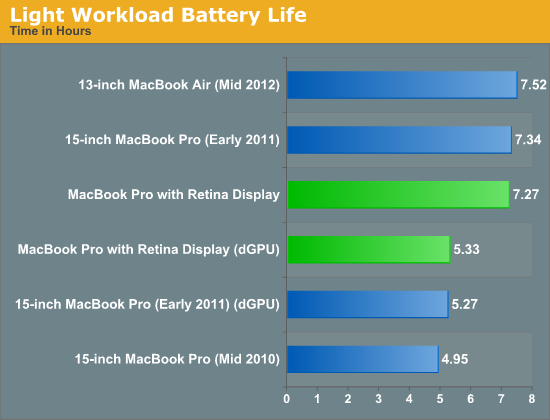
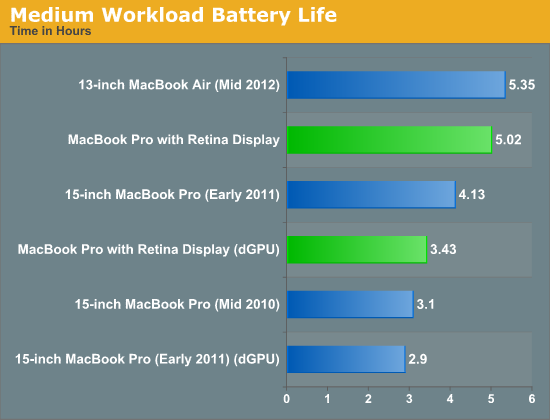
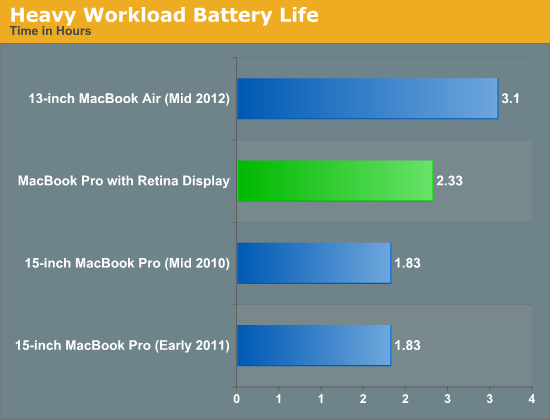
Overall the rMBP pretty much behaves as expected. Apple claims up to 7 hours of battery life and using our light workload we see a bit over that. Fire up the dGPU and even a light workload will get cut down to around 5.5 hours. Moderate usage will drop battery life to around 5 hours, and if you fire up the dGPU you’ll see that cut down to 3.5. The heavy multitaskers in the audience will see a bit above 2 hours out of a single charge. Note that all of these numbers are at 100 nits, drive the 2880 x 1800 panel at its full brightness and you can expect a tangible reduction in battery life.
The rMBP’s integrated 95Wh battery is ginormous by today’s standards, but it’s really necessary to drive both the silicon and that impressive panel. Subjectively I did find the rMBP lasted longer than last year’s MacBook Pro, despite the similar max battery life ratings. My experiences were echoed by the results in our tests.
I suspect most users will see around 5 hours of battery life out of the system compared to a bit under 4 hours out of last year’s machine. At minimum brightness, typing a long document (similar to what I’m doing right now) you can significantly exceed Apple’s 7 hour estimate. As always it really depends on usage model. Professional users doing a lot of photo and video editing aren’t going to see anywhere near the max battery life, while the writers and general users will be quite happy.
One trick to maximizing battery life on light or moderate workloads is to keep an eye on what the discrete GPU is doing. I still find that OS X will wake up the discrete GPU far too frequently, even when in my opinion its services aren’t needed. As always I turn to Cody Krieger’s excellent gfxCardStatus app for keeping an eye on which GPU is driving the panel. The app has been updated and is now fully compatible with the rMBP.


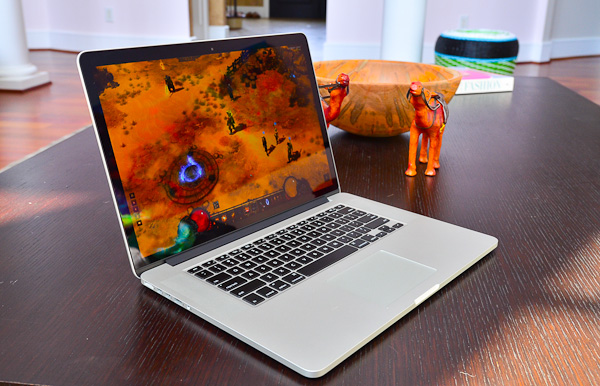
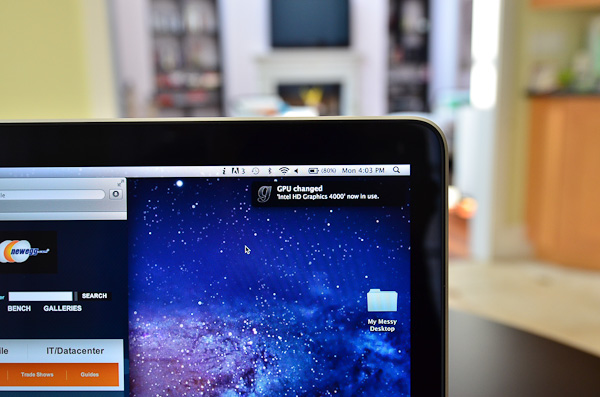








471 Comments
View All Comments
Super56K - Saturday, June 23, 2012 - link
Maybe talking paper specs on the software side it's 'the same' but really that's not even close. Dpi scaling is flaky in Windows anyways.And it's really not the same. It's rendered at double the resolution on a screen that actually has 4x's the pixels at the native 1440x900 res. Nobody else does that. Hell, it's rare to even find a 16:10 Windows laptop.
I don't own a MacBook anything, but some of you sound ridiculous in here going on about Sony laptops with 1080p screens
Spunjji - Tuesday, June 26, 2012 - link
What if I, the user, don't want my laptop rendering the display at a pointlessly high resolution just to scale it back down again? I understand the theory but the execution is utterly ridiculous.UpSpin - Saturday, June 23, 2012 - link
You're right, it wouldn't sell, because the issue is that Windows DPI scaling doesn't work so well. It also doesn't work perfectly in Mac OS (Chrome best example, they had to update it). And so will many older programs, which don't receive further updates, like Adobe Creative Suite <6 don't scale right (assumption)That's one reason that Apple released only one MacBook with a retina display, because the software isn't ready for DPI scaling yet. Apple was brave enough to do the step and force programers to integrate scaling in high res images in their programs because future MacBooks will have retina displays only.
No PC manuafcturer could have done such a step, they would have been blocked by the lack of proper scaling of Windows, rendering a high res display useless because of display errors. So Microsoft should have made Windows 7 resolution independent (just as all mobile OS are, which rely on DPI instead of absolute pixels), then PC manufacturers could have included high res displays which the customer could have used.
EnzoFX - Saturday, June 23, 2012 - link
MS Should have with Win7? Hardly. That was too long ago and there were no retina screens yet. Even 1080p screens were scarce. Remember that 99% were getting 1366x768 in their laptops.You're right in that Apple can sort of force developers to update apps for support. I do give them credit for usually implementing a solid stopgap. Their scaling for older apps is usually good enough without it being a bad experience. Forcing them to update is a good thing though, having that ecosystem of active developers is good. It's further easier on them to target simple hardware configurations. The benefits of vertical integration at its best. Now for these retina displays to trickle down to all their displays =P.
ananduser - Saturday, June 23, 2012 - link
Win7 scales perfectly well for a screen this res. Such an absurd panel jump however is meant as bragging rights. It also serves as differentiation. Instead of going "post PC" like W8 transformer devices at Computex, it adds a huge panel. There's nothing special about the hardware that hasn't been done before, except the impressive panel.Ohhmaagawd - Saturday, June 23, 2012 - link
Exactly what would constitute "special"?dagamer34 - Sunday, June 24, 2012 - link
Mobile operating systems aren't resolution independent. The iPhone supports 2 resolutions, Windows Phone currently supports 1 resolution, but will support 3 in WP8, and Android supports a variety of resolutions, but is NOT resolution independent.garcondebanane - Saturday, June 23, 2012 - link
Frankly, yes I think so. See "the software side of retina" and "Achieving retina".I don't think any other PC manufacturer can realistically be expected to do it this seamlessly.
UberApfel - Saturday, June 23, 2012 - link
Apple didn't think of the idea. The screens are simply now available and Apple has the resources and reason to push it to market first. Apple also has their own operating system and software engineers to prepare for such.Anyone familiar with the market knows that Microsoft is a big kid nurtured by monopoly and ripping off corporations. The 'big game-changing release & failure' every few years just doesn't allow manufacturers to be first-adopters. Only OSX stays up-to-date, and only Apple may use OSX thanks to either IP or special-order hardware.
If Asus, Acer, or Toshiba were to shell out the cash to get a portion of the first batch and mass-produce some laptops w/ "retina display"; they'd just have a deficit. Apple is a designer; not a innovator. Anyone who makes that mistake is a fool.
MrSpadge - Monday, June 25, 2012 - link
It's not only about thinking about it, it's about building it and reaching out to make people buy it. It's hard to do this without the "Apple hype", no matter how good and innovative the product may be.